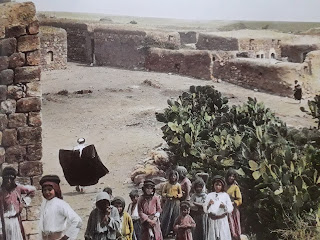In this article, I would like to share some of the beautiful hand-painted photographs in one of my favorite books entitled In the Footsteps of Abraham: The Holy Land in Hand-Painted Photographs by Richard Hardiman and Helen Speelman. Although this book consists mainly of photographs, I never get tired of it because I just love to look at the astounding color portrait of the Holy Land, captured before these biblical landscapes were brought forward into the modern era. This book is very special to me because it provides a unique opportunity for me to experience the people, landscapes, and architecture of the Holy Land as they were at the turn of the last century before the region underwent the radical changes of modernization. The vivid and rare photographs in this book which were taken before the advent of commercial color photography, clearly depict the Holy Land of more than 2000 years ago when Jesus walked upon this earth. These wonderful photographs were taken by the Matson Photo Agency, part of Jerusalem's American Colony, a community of Christian expatriates.
In the 1920s, Arie Speelman (Helen Speelman's grandfather), a devout Dutch Christian, commissioned the hand-coloring of of 1200 photos on glass plates, a massive undertaking that sometimes involved painting with a single human hair. He traveled to Holland with the hand-colored glass plates giving popular lantern slide lectures. Coloring individual lantern slides or photographs was a time-consuming activity requiring much concentration, cost, and skill. His entire collection was bequeathed to the Jewish historical Museum in Amsterdam. It is one of the few fully hand-colored sets in existence, and certainly one of the largest. The attention to detail employed in painting these lantern slides is such that, in many instances, the image can hardly be differentiated from modern color photography. The 172 full-page images in this book were selected from that special legacy. Bearing in mind that only black and white photography was commercially available at the time these photos were taken, this was indeed an incredibly unusual undertaking on such large group of photos. What is really amazing is that these photos that were originally black and white have made history come to life with colors. And I am happy to say that looking at these photos makes me feel closer to Jesus. That was why the moment I looked at this oversized album, I knew that I must make it mine.
Since this book is too big for my scanner, I had to photograph the images in this oversized album using my smart phone so the photos that I uploaded here may not be as beautiful and colorful as the original images in this book (probably because I couldn't get the lighting right on these photographs). I couldn't photograph the whole image and the color is also slightly different. Nevertheless, they clearly illustrate the natural wonders of the Holy Land before the modernization processes took place.
The Old City of Jerusalem from Government House. In the distance you can make out the high mountains of Moab. Can you imagine how this photo would look like in black and white? From a boring black and white photo, it has turned into a beautiful landscape with colors.
The Western, or Wailing, Wall. When these photos were taken, the sites, customs, and costumes were very similar to those of Biblical times. Looking at the people in this photo reminds me of Jesus and the people he associated with every day.
Possible Site of Christ's Baptism. It looks very much alive in colors bringing back the scenes of Jesus' baptism more vividly than the most powerful descriptions. At risk of going dry, the Jordan River has sunk so low that it is not possible for Jesus to plunge into it today.
Children on Road to Entrance of Anata, the birthplace of the prophet Jeremiah. Anata is now a large town in the urban area to the north of Jerusalem with many grocery shops and restaurants.
Change is inevitable and the Holy Land's infrastructure has undergone rapid development especially in the past decade. Thanks to Arie Speelman's hard work, we can still walk in the footsteps of Jesus and see the Holy Land just as He saw it more than 2000 years ago in this era of modernity within this region.
Reference:
Hardiman, Richard & Speelman, Helen. (2008). In the footsteps of Abraham: The Holy Land in hand-painted photographs. New York: Overlook Duckworth.






No comments:
Post a Comment